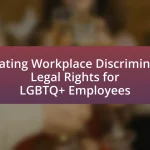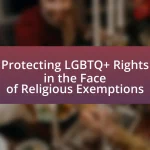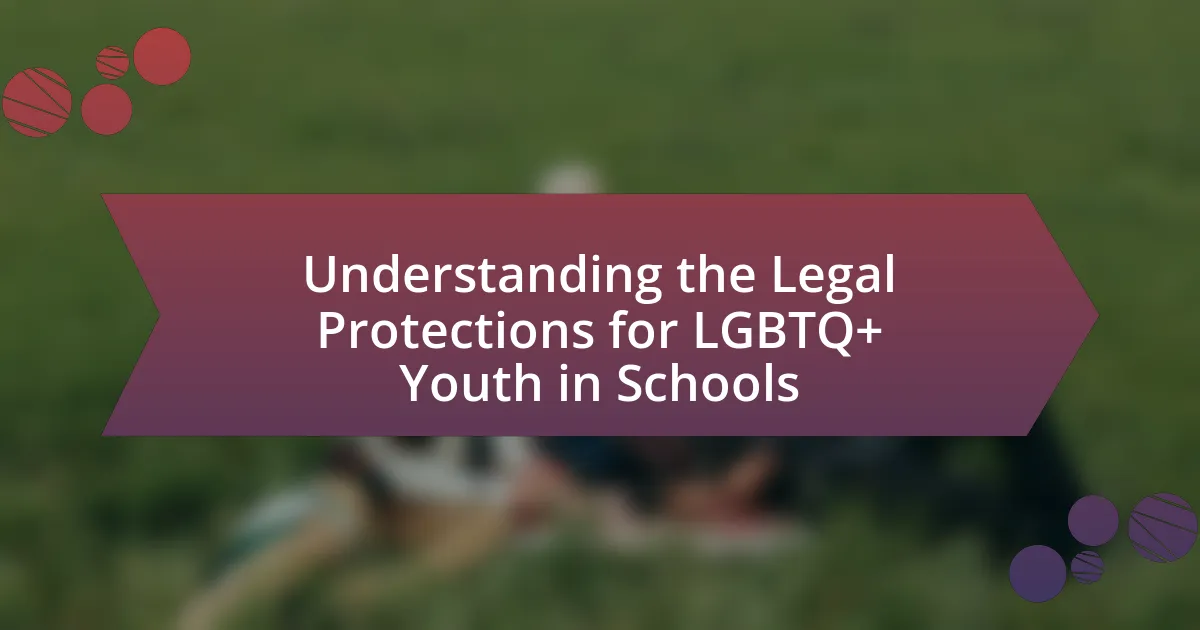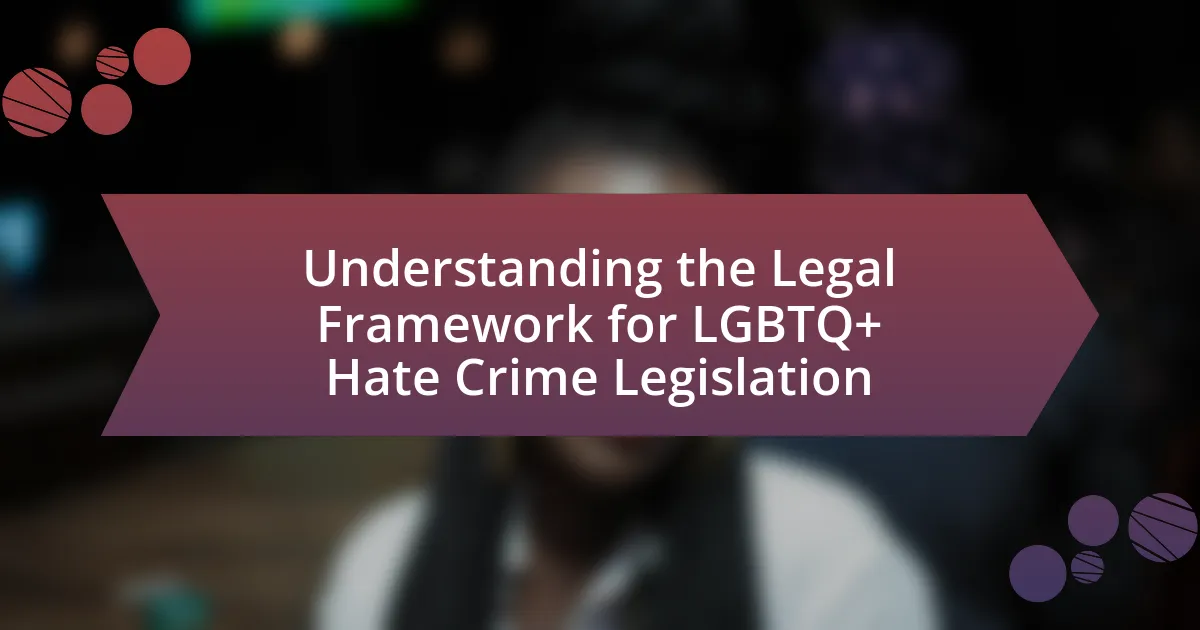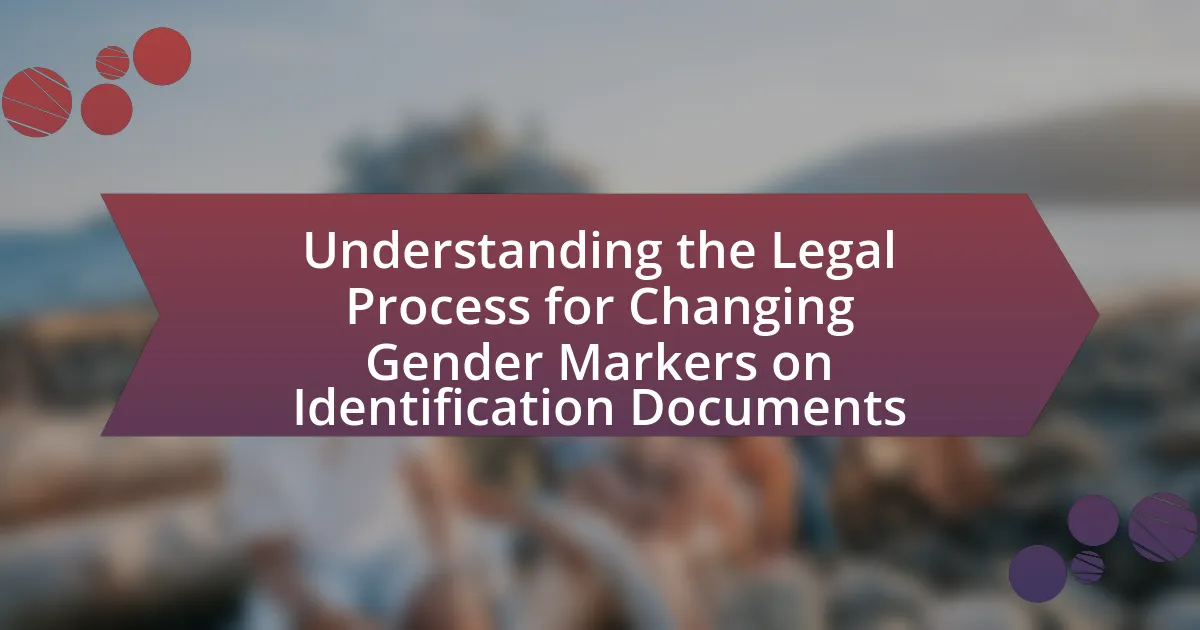LGBTQ+ rights in adoption and foster care encompass the legal protections and recognition for LGBTQ+ individuals and couples seeking to adopt or foster children. The article outlines the evolution of these rights, highlighting significant legal milestones such as the Obergefell v. Hodges ruling, which established marriage equality and influenced adoption laws. It examines the varying state laws and federal frameworks that govern LGBTQ+ adoption rights, the challenges faced by LGBTQ+ individuals during the adoption process, and the impact of societal attitudes on these rights. Additionally, the article discusses international perspectives on LGBTQ+ adoption, the role of advocacy groups, and best practices for LGBTQ+ individuals pursuing adoption.

What are LGBTQ+ Rights in Adoption and Foster Care?
LGBTQ+ rights in adoption and foster care refer to the legal protections and recognition afforded to LGBTQ+ individuals and couples seeking to adopt or foster children. In many jurisdictions, laws have evolved to prohibit discrimination based on sexual orientation and gender identity, allowing LGBTQ+ individuals to adopt and foster children on equal terms with heterosexual individuals. For instance, the U.S. Supreme Court’s decision in Obergefell v. Hodges (2015) established the constitutional right to same-sex marriage, which has implications for adoption rights, as married couples, regardless of sexual orientation, are generally treated equally under adoption laws. Additionally, various states have enacted specific legislation to affirm the rights of LGBTQ+ parents, ensuring that they can provide stable and loving homes for children in need.
How have LGBTQ+ rights evolved in the context of adoption and foster care?
LGBTQ+ rights in the context of adoption and foster care have evolved significantly over the past few decades, marked by a shift from widespread discrimination to increasing legal recognition and protections. In the 1990s, many states had laws explicitly prohibiting LGBTQ+ individuals from adopting or fostering children, reflecting societal stigma and bias. However, landmark legal decisions, such as the 2015 Supreme Court ruling in Obergefell v. Hodges, which legalized same-sex marriage, set a precedent for broader LGBTQ+ rights, including in adoption and foster care.
As of 2023, numerous states have enacted laws that explicitly allow LGBTQ+ individuals and couples to adopt and foster children, with organizations like the Child Welfare League of America advocating for inclusive practices. Research indicates that children raised in LGBTQ+ households fare just as well as those in heterosexual households, further supporting the case for equality in adoption and foster care. Additionally, the federal government has taken steps to protect LGBTQ+ rights in these areas, including guidance from the Department of Health and Human Services affirming that discrimination based on sexual orientation or gender identity is prohibited in federally funded programs.
What historical milestones have shaped LGBTQ+ adoption rights?
The historical milestones that have shaped LGBTQ+ adoption rights include the decriminalization of homosexuality, the legalization of same-sex marriage, and landmark court rulings affirming parental rights. The American Psychological Association’s 1973 decision to remove homosexuality from its list of mental disorders marked a significant shift in societal attitudes, paving the way for legal reforms. The 2015 Supreme Court ruling in Obergefell v. Hodges legalized same-sex marriage nationwide, which directly impacted adoption rights by allowing same-sex couples to adopt children in all states. Additionally, various state-level rulings, such as the 2008 California Supreme Court decision in In re Marriage Cases, recognized the parental rights of same-sex couples, further solidifying their ability to adopt. These milestones collectively reflect the evolving legal landscape that supports LGBTQ+ individuals and couples in their pursuit of adoption rights.
How do societal attitudes influence LGBTQ+ rights in adoption?
Societal attitudes significantly influence LGBTQ+ rights in adoption by shaping public policy and legal frameworks. Positive societal attitudes towards LGBTQ+ individuals often lead to more inclusive laws and practices, as seen in countries like Canada and the Netherlands, where same-sex couples have equal adoption rights. Conversely, negative societal attitudes can result in restrictive laws, as evidenced in some U.S. states where legislation limits adoption rights for LGBTQ+ individuals. Research from the Williams Institute indicates that states with more accepting attitudes towards LGBTQ+ people tend to have fewer legal barriers for adoption, highlighting the direct correlation between societal perceptions and legal rights in this area.
What legal frameworks govern LGBTQ+ rights in adoption and foster care?
Legal frameworks governing LGBTQ+ rights in adoption and foster care primarily include federal laws, state laws, and court rulings. The federal law, such as the Adoption and Safe Families Act, does not explicitly mention sexual orientation but has been interpreted to protect LGBTQ+ individuals from discrimination. Additionally, the U.S. Supreme Court ruling in Obergefell v. Hodges (2015) established the constitutional right to same-sex marriage, which has implications for adoption rights. State laws vary significantly; some states have inclusive policies that explicitly allow LGBTQ+ individuals and couples to adopt, while others may have restrictive laws or lack protections against discrimination. For instance, states like California and New York have comprehensive laws supporting LGBTQ+ adoption rights, while others may permit discrimination based on sexual orientation. These legal frameworks collectively shape the landscape of LGBTQ+ rights in adoption and foster care across the United States.
Which federal laws impact LGBTQ+ adoption rights?
The federal laws that impact LGBTQ+ adoption rights include the Adoption and Safe Families Act (ASFA), the Multi-Ethnic Placement Act (MEPA), and the Child Welfare Act. ASFA promotes the adoption of children in foster care and prohibits discrimination based on sexual orientation in the adoption process. MEPA aims to prevent discrimination in the placement of children based on race, color, or national origin, which extends to LGBTQ+ individuals seeking to adopt. The Child Welfare Act supports the rights of all individuals, including LGBTQ+ parents, to adopt and foster children. These laws collectively ensure that LGBTQ+ individuals have equal opportunities in adoption and foster care settings.
How do state laws vary regarding LGBTQ+ rights in foster care?
State laws regarding LGBTQ+ rights in foster care vary significantly across the United States. Some states have inclusive policies that explicitly protect LGBTQ+ individuals from discrimination in the foster care system, while others have laws that allow for discrimination based on sexual orientation or gender identity. For instance, California and New York have comprehensive protections that ensure LGBTQ+ individuals can foster and adopt without facing bias, whereas states like Texas and Florida have enacted laws that permit agencies to refuse placements based on religious beliefs, which can adversely affect LGBTQ+ applicants. This variation reflects broader societal attitudes and legal interpretations regarding LGBTQ+ rights, impacting the availability and accessibility of foster care for LGBTQ+ individuals.
What challenges do LGBTQ+ individuals face in the adoption process?
LGBTQ+ individuals face significant challenges in the adoption process, primarily due to legal barriers, societal stigma, and discrimination. Many jurisdictions have laws that explicitly or implicitly discriminate against LGBTQ+ individuals, making it difficult for them to adopt. For instance, some states have enacted legislation that allows adoption agencies to refuse services based on religious beliefs, which can disproportionately affect LGBTQ+ applicants. Additionally, societal biases can lead to negative perceptions and treatment from adoption agencies and birth parents, further complicating the process. Research from the Williams Institute indicates that LGBTQ+ individuals are more likely to experience discrimination in family-building processes compared to their heterosexual counterparts, highlighting the systemic issues they face in adoption.
What discrimination issues arise during the adoption process for LGBTQ+ individuals?
Discrimination issues that arise during the adoption process for LGBTQ+ individuals include bias from adoption agencies, legal barriers, and societal stigma. Adoption agencies may exhibit discriminatory practices by favoring heterosexual couples over LGBTQ+ applicants, which can be evidenced by reports indicating that some agencies have policies that explicitly or implicitly prioritize traditional family structures. Legal barriers also exist, as certain states have laws that allow discrimination based on sexual orientation, impacting the ability of LGBTQ+ individuals to adopt. Additionally, societal stigma can lead to negative perceptions and treatment of LGBTQ+ individuals seeking to adopt, further complicating their journey. These factors collectively create significant challenges for LGBTQ+ individuals in the adoption process.
How do biases in the foster care system affect LGBTQ+ applicants?
Biases in the foster care system negatively impact LGBTQ+ applicants by creating barriers to their acceptance and placement as foster parents. Research indicates that LGBTQ+ individuals often face discrimination from social workers and agencies, which can lead to fewer opportunities for fostering children. A study by the Williams Institute found that LGBTQ+ individuals are more likely to experience rejection or negative treatment during the application process, with 30% of LGBTQ+ applicants reporting that they felt unwelcome or discriminated against. This systemic bias not only affects the applicants’ emotional well-being but also limits the pool of potential foster parents, ultimately impacting the children in need of stable homes.

How do LGBTQ+ rights in adoption and foster care compare internationally?
LGBTQ+ rights in adoption and foster care vary significantly across countries, with some nations fully recognizing these rights while others impose restrictions or outright bans. For instance, countries like Canada and the Netherlands allow same-sex couples to adopt children and have inclusive foster care policies, reflecting progressive legal frameworks that support LGBTQ+ families. In contrast, nations such as Russia and several Middle Eastern countries have laws that prohibit same-sex couples from adopting or fostering children, often citing traditional family structures as justification. According to a 2021 report by the International Lesbian, Gay, Bisexual, Trans and Intersex Association (ILGA), only 28 countries globally allow same-sex couples to adopt jointly, highlighting the disparity in legal recognition and protections for LGBTQ+ individuals in the context of adoption and foster care.
What are the global perspectives on LGBTQ+ adoption rights?
Global perspectives on LGBTQ+ adoption rights vary significantly, reflecting cultural, legal, and social attitudes towards LGBTQ+ individuals. In countries like Canada, the Netherlands, and Spain, LGBTQ+ individuals and couples have equal adoption rights, supported by legal frameworks that recognize same-sex marriage and family rights. Conversely, in nations such as Russia, Uganda, and many Middle Eastern countries, LGBTQ+ adoption rights are severely restricted or outright banned, often influenced by conservative cultural and religious beliefs. According to a 2021 report by the International Lesbian, Gay, Bisexual, Trans and Intersex Association (ILGA), only 28 countries allow same-sex couples to adopt children, highlighting the disparity in global acceptance and legal recognition of LGBTQ+ families.
Which countries have progressive laws regarding LGBTQ+ adoption?
Countries with progressive laws regarding LGBTQ+ adoption include Canada, the Netherlands, Spain, and Sweden. In Canada, same-sex couples have had the right to adopt since 2002, and the country recognizes joint adoption for same-sex partners. The Netherlands was the first country to legalize same-sex marriage in 2001 and allows LGBTQ+ individuals and couples to adopt. Spain legalized same-sex marriage in 2005, granting adoption rights to same-sex couples. Sweden has also recognized the adoption rights of same-sex couples since 2003, allowing them to adopt jointly. These countries demonstrate a commitment to equality in family rights for LGBTQ+ individuals.
How do international treaties influence LGBTQ+ adoption rights?
International treaties significantly influence LGBTQ+ adoption rights by establishing legal frameworks that promote equality and non-discrimination. For instance, treaties such as the Convention on the Rights of the Child (CRC) emphasize the importance of the best interests of the child and the right to a family environment, which can support LGBTQ+ individuals seeking to adopt. Additionally, the Yogyakarta Principles, which address the application of international human rights law in relation to sexual orientation and gender identity, advocate for the recognition of LGBTQ+ families and their rights to adopt. These treaties create pressure on countries to align their domestic laws with international standards, thereby enhancing adoption rights for LGBTQ+ individuals in jurisdictions that may have previously restricted such rights.
What role do advocacy groups play in promoting LGBTQ+ rights in adoption?
Advocacy groups play a crucial role in promoting LGBTQ+ rights in adoption by raising awareness, influencing policy, and providing support to LGBTQ+ individuals and families. These organizations, such as the Human Rights Campaign and Family Equality, actively campaign for legal reforms that ensure equal treatment in adoption processes, highlighting the importance of non-discrimination laws. For instance, they have successfully lobbied for the repeal of discriminatory laws in various states, leading to increased acceptance and legal recognition of LGBTQ+ adoptive parents. Additionally, advocacy groups offer resources and guidance to LGBTQ+ families navigating the adoption system, helping to create a more inclusive environment. Their efforts contribute to changing societal perceptions and fostering a legal framework that supports LGBTQ+ rights in adoption.
How do these organizations support LGBTQ+ individuals in the adoption process?
Organizations support LGBTQ+ individuals in the adoption process by providing legal assistance, advocacy, and resources tailored to their unique needs. For instance, organizations like the Human Rights Campaign and Family Equality offer guidance on navigating the legal complexities of adoption, ensuring that LGBTQ+ individuals understand their rights and options. Additionally, these organizations often engage in advocacy efforts to promote inclusive policies and practices within adoption agencies, which can lead to more equitable treatment of LGBTQ+ applicants. Research indicates that LGBTQ+ individuals face barriers in the adoption process, and these organizations work to dismantle those barriers through education and support, thereby fostering a more inclusive environment for all prospective parents.
What campaigns have been effective in raising awareness about LGBTQ+ adoption rights?
Effective campaigns that have raised awareness about LGBTQ+ adoption rights include the “Adoption Equality” campaign by the Human Rights Campaign, which highlighted the disparities faced by LGBTQ+ individuals in adoption processes. This campaign utilized social media, public events, and partnerships with local organizations to disseminate information and advocate for policy changes. Additionally, the “Family Equality Council” has run campaigns such as “Out in the Open,” which focused on personal stories of LGBTQ+ families to humanize the issue and promote acceptance. These campaigns have successfully engaged the public and influenced legislative discussions, contributing to increased visibility and support for LGBTQ+ adoption rights.

What are the implications of recent legal changes on LGBTQ+ adoption rights?
Recent legal changes have significantly expanded LGBTQ+ adoption rights, allowing same-sex couples greater access to adopt children in various jurisdictions. For instance, rulings by the U.S. Supreme Court, such as Obergefell v. Hodges in 2015, established marriage equality, which has directly influenced adoption laws by affirming that same-sex couples have the same legal standing as heterosexual couples in family law matters. Additionally, states like California and Illinois have enacted laws that explicitly prohibit discrimination based on sexual orientation in adoption processes, further solidifying the rights of LGBTQ+ individuals and couples. These changes have led to an increase in the number of LGBTQ+ families adopting children, contributing to a more inclusive environment in child welfare systems.
How do recent court rulings affect LGBTQ+ rights in adoption and foster care?
Recent court rulings have positively impacted LGBTQ+ rights in adoption and foster care by affirming the legal recognition of same-sex couples as equal to heterosexual couples in these processes. For instance, the U.S. Supreme Court’s decision in Obergefell v. Hodges (2015) established that same-sex marriage is a constitutional right, which subsequently influenced lower court rulings to extend adoption rights to LGBTQ+ individuals and couples. Additionally, various state courts have ruled that discrimination against LGBTQ+ individuals in adoption and foster care violates anti-discrimination laws, further solidifying their rights. These rulings collectively enhance the ability of LGBTQ+ individuals to adopt and foster children, promoting equality in family formation.
What specific cases have set precedents for LGBTQ+ adoption rights?
The specific cases that have set precedents for LGBTQ+ adoption rights include “In re Adoption of T.A.M.” in 2006, where the Iowa Supreme Court ruled in favor of a same-sex couple’s right to adopt, and “Obergefell v. Hodges” in 2015, which legalized same-sex marriage and subsequently impacted adoption rights. These cases established legal recognition and protections for LGBTQ+ individuals seeking to adopt, affirming their rights in the context of family law. The Iowa case specifically highlighted the importance of non-discrimination in adoption processes, while the Obergefell ruling underscored the equal treatment of same-sex couples in all aspects of family law, including adoption.
How do changes in administration impact LGBTQ+ adoption policies?
Changes in administration significantly impact LGBTQ+ adoption policies by altering the legal framework and enforcement of non-discrimination protections. For instance, the Obama administration implemented policies that explicitly prohibited discrimination against LGBTQ+ individuals in adoption and foster care, while the Trump administration rolled back many of these protections, allowing states to enact laws that could deny adoption rights based on sexual orientation. This shift is evidenced by the 2018 ruling from the U.S. Department of Health and Human Services, which allowed faith-based agencies to refuse services to LGBTQ+ families. Consequently, the political climate and leadership directly influence the accessibility and rights of LGBTQ+ individuals seeking to adopt.
What best practices can LGBTQ+ individuals follow when pursuing adoption?
LGBTQ+ individuals pursuing adoption should prioritize understanding the legal landscape and ensuring their rights are protected throughout the process. Research indicates that LGBTQ+ parents can face unique challenges, including discrimination and varying state laws regarding adoption rights. Therefore, it is essential for LGBTQ+ individuals to seek legal counsel experienced in LGBTQ+ family law to navigate these complexities effectively. Additionally, joining support groups or networks can provide valuable resources and shared experiences, enhancing the adoption journey. Studies show that children raised by LGBTQ+ parents fare just as well as those raised by heterosexual parents, reinforcing the importance of inclusivity in adoption practices.
How can LGBTQ+ individuals prepare for the adoption process?
LGBTQ+ individuals can prepare for the adoption process by educating themselves about the legal requirements and procedures specific to their jurisdiction. Understanding local laws is crucial, as adoption regulations can vary significantly by state or country, impacting eligibility and the overall process. Additionally, LGBTQ+ individuals should consider engaging with adoption agencies that are affirming and experienced in working with LGBTQ+ families, as these agencies can provide tailored support and resources. Research indicates that LGBTQ+ parents can face unique challenges, so connecting with support groups or networks can also be beneficial for sharing experiences and advice.
What resources are available for LGBTQ+ individuals seeking to adopt?
LGBTQ+ individuals seeking to adopt can access various resources, including advocacy organizations, legal assistance, and support networks. Organizations such as the Human Rights Campaign and Family Equality provide information on adoption laws, resources for prospective parents, and connections to LGBTQ+-friendly adoption agencies. Additionally, legal resources like the National Center for Lesbian Rights offer guidance on navigating the legal aspects of adoption for LGBTQ+ families. These resources are essential for ensuring that LGBTQ+ individuals understand their rights and options in the adoption process.

